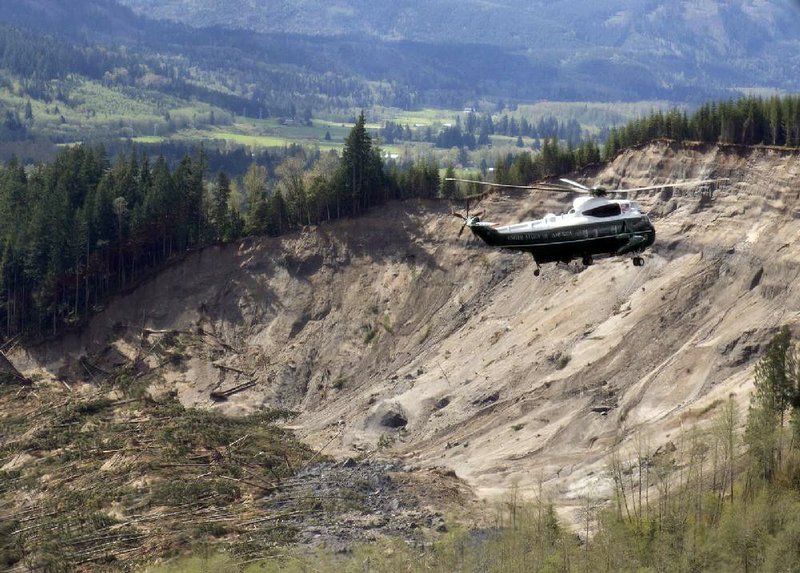OSO, Wash. - President Barack Obama took an aerial tour Tuesday of the place where more than three dozen people died in a mudslide last month. He later pledged a nation’s solidarity with those who are enduring “unimaginable pain and difficulty” in the aftermath of the destruction.
“We’re going to be strong right alongside you,” Obama promised the people whose lives were upended when a wall of mud and water swept away the hillside on March 22 and took with it at least 41 lives and dozens of homes.
Earlier, Obama boarded a helicopter to survey the scene.
Evidence of the mudslide’s power was everywhere: trees ripped from the ground, a highway paved with mud and debris, a river’s course altered. As the president flew overhead, the search for bodies continued. Two people were still listed as missing Tuesday.
Back on the ground, the president gathered at a community chapel in the small town of Oso, about an hour northeast of Seattle, to mourn with families of the victims. He met separately with emergency responders before speaking in a small, brick firehouse about all he had seen and heard on a clear, sunny afternoon.
“The families that I met with showed incredible strength and grace through unimaginable pain and difficulty,” Obama said. Then he offered them a promise.
“The whole country’s thinking about you, and we’re going to make sure that we’re there every step of the way as we go through the grieving, the mourning, the recovery,” he said.
Obama said few Americans had heard of the tight knit community of Oso before the tragedy but in the past month “we’ve all been inspired by the incredible way that the community has come together.”
Brande Taylor, whose boyfriend was a volunteer working on the mudslide debris field, was appreciative that the president made the effort to visit the town.
“It is a small community. It’s little. It’s not huge on the map. But there’s still people here who need help, that need the support,” said Taylor, who stood near the firehouse. “And they need to know the president is here to support and to help them rebuild their lives.”
Kellie Perkins, who lives in Oso, said Obama’s visit would help families who have lost so much to begin to heal.
“They don’t now have houses any more, they don’t have anything they own, their friends or relatives are dead,” she said. “I think they need this.”
At the request of Washington Gov. Jay Inslee, Obama earlier this month declared that a major disaster had occurred in the state, making it and affected residents eligible for financial aid, including help covering the costs of temporary housing, home repairs and the loss of uninsured property. The Homeland Security Department, the Federal Emergency Management Agency and the Army Corps of Engineers also are helping.
But more help is needed, and for many residents of nearby Darrington and Arlington, that would include reopening Washington 530 as soon as possible. Its closure since the mudslide has created a two hour detour between the two cities.
“That highway is a lifeline for this community, both economically and socially,” saidDr. Gary Schillhammer at the Darrington Clinic.
The highway’s closure prevents him from seeing patients at Cascade Valley Hospital in Arlington, which he visited several times a week before the slide. It also means that the nearest full-service emergency room to Darrington is now an hour away in Sedro-Woolley, instead of a half-hour away in Arlington.
Darrington Mayor Dan Rankin said before Obama’s visit that he wanted the president to understand the extent of the mudslide’s effect on the Stillaguamish Valley.
“Unless you actually see it for yourself, you can’t understand the magnitude of this event, the loss the families have suffered and how this has changed this valley forever,” Rankin said.
Information for this article was contributed by Darlene Superville and Manuel Valdes of The Associated Press and by Jack Broom of The Seattle Times.
Front Section, Pages 4 on 04/23/2014


